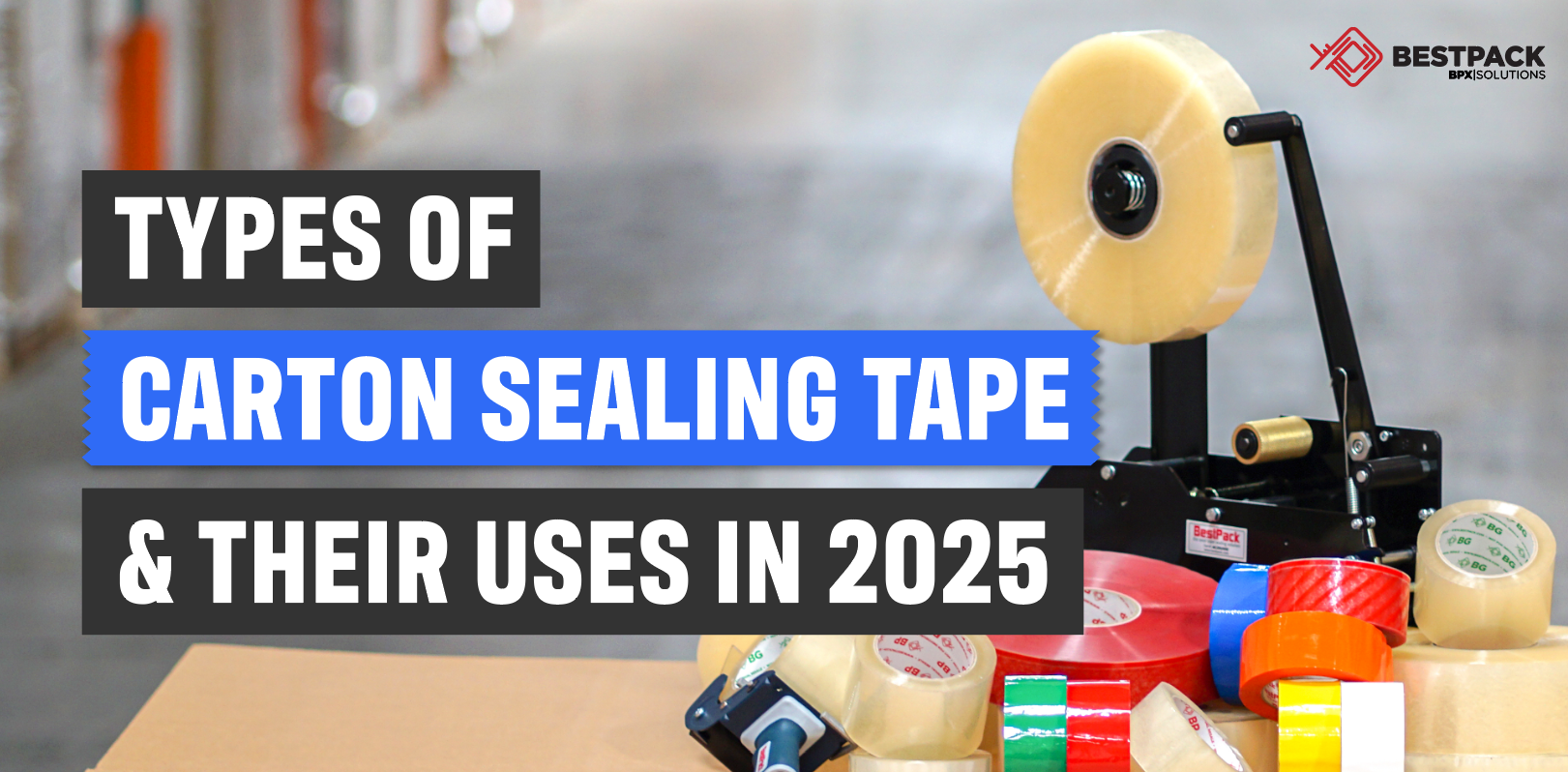
In the dynamic world of packaging and shipping, selecting the right carton sealing tape is more critical than ever. As businesses strive to ensure their products reach customers in optimal condition, the role of high-quality, reliable sealing tape cannot be overstated. The year 2025 brings an array of advanced tape technologies designed to meet diverse packaging needs, from simple storage solutions to robust shipping demands. With innovations in adhesive technology and materials, today’s carton sealing tapes offer enhanced durability, strength, and versatility.
This comprehensive guide will delve into the various types of carton sealing tape available in 2025, exploring their unique characteristics and ideal applications. By understanding the different options, including eco-friendly choices that help reduce a company’s carbon footprint and support sustainability goals, businesses can make informed decisions that enhance their packaging processes, reduce costs, and ensure the safe delivery of their products. Whether you’re involved in e-commerce, manufacturing, or logistics, selecting the right tape is crucial for optimizing efficiency and maintaining the quality of your shipments.
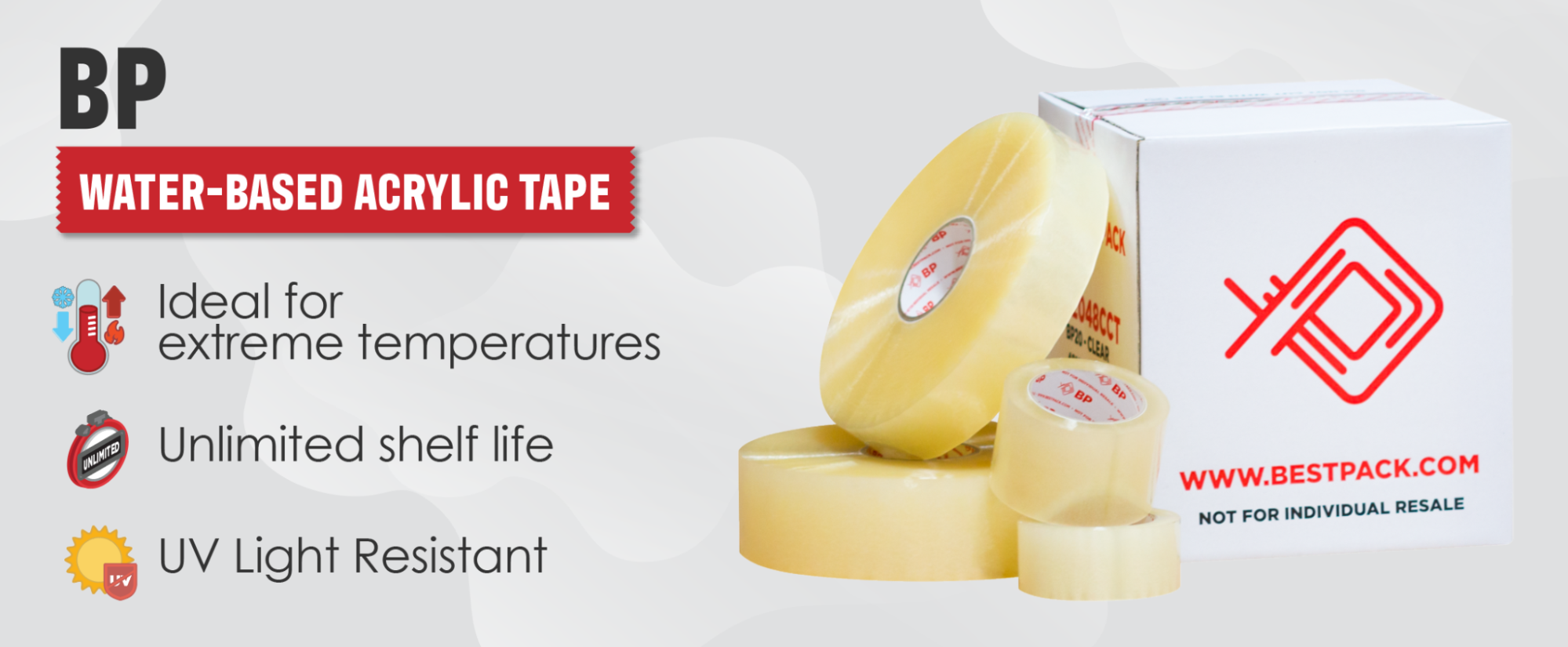
The BP Water-Based Acrylic Tape is designed to perform exceptionally well in extreme temperature conditions. This tape is equipped with UV radiation protection, ensuring it does not yellow over time, which is particularly beneficial for maintaining a clean and professional appearance in long-term storage or outdoor applications.
Its excellent clarity makes it a preferred choice for food packaging operations, where visibility and aesthetics are important. Utilizing a high-quality Rohm & Haas acrylic adhesive, this tape provides a strong and reliable seal. It’s versatile and durable, making it suitable for a wide range of packaging needs. Whether you are sealing boxes for shipment or storage, BP Water-Based Acrylic Tape offers a dependable solution that can withstand environmental challenges.
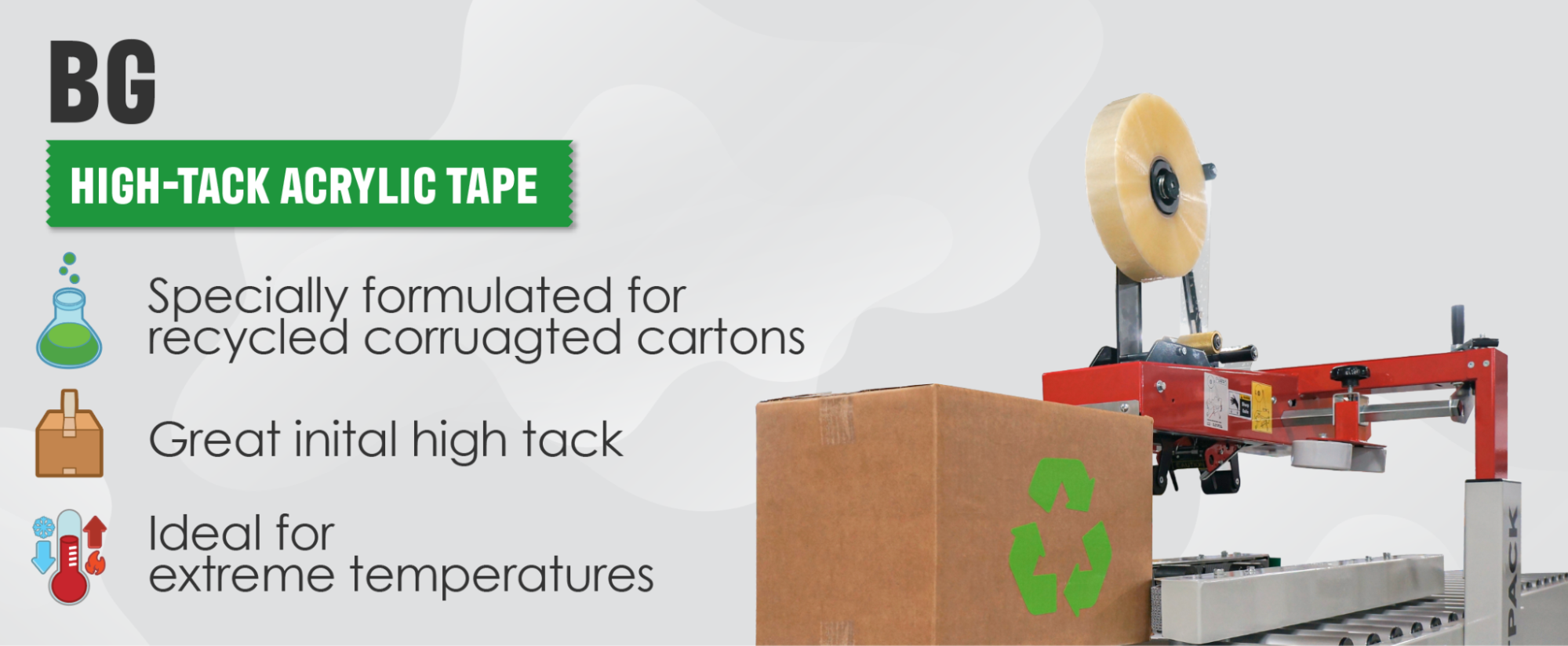
BG High Tack Tape is specially formulated for use with 100% recycled corrugated cartons, providing an eco-friendly packaging solution. This tape features an acrylic adhesive with a hot melt feature, which is what makes the BG special. This combination offers high tack, making it a great alternative to traditional hot-melt tapes, especially in environments where extreme temperatures are a concern.
Its formulation ensures a secure seal even in challenging conditions, which is crucial for maintaining the integrity of recycled corrugated boxes during transit. The BG High Tack Tape is ideal for businesses that prioritize sustainability without compromising on performance. The tape’s robust adhesive properties make it a reliable choice for various packaging scenarios, including shipping and storage.
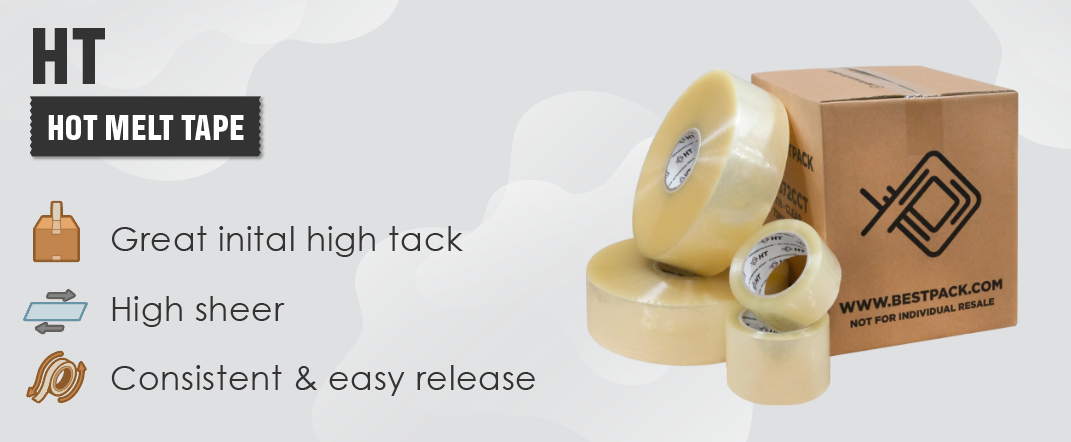
HT Hot Melt Tape is known for its consistent release coating and aggressive synthetic rubber adhesive. This tape provides an increased tack and shear, ensuring a consistent and secure seal for a wide range of packaging applications. It is particularly suitable for high-volume packaging operations, where speed and efficiency are paramount.
The HT Hot Melt Tape is designed to maintain its adhesive properties under various handling processes, making it an excellent choice for e-commerce and other industries that require reliable sealing solutions. Its durability and strong bonding capabilities make it ideal for sealing cartons that are subjected to different conditions during transit. This tape ensures that packages arrive at their destination intact and securely sealed.
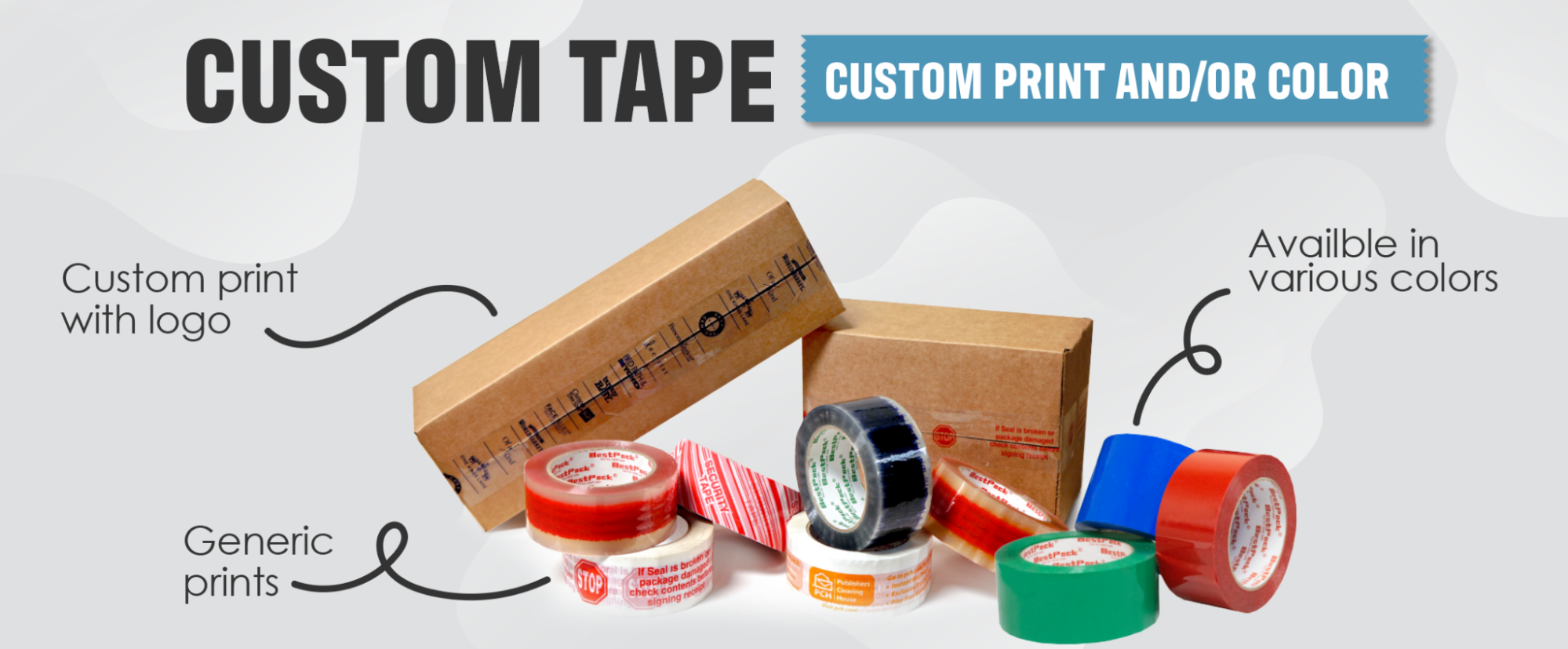
Companies like BestPack offer a wide range of custom packing tapes, including generic prints and specialized lock or surface print options. These tapes are available in various colors, including red, blue, green, yellow, orange, tan, white, and clear, allowing for customization to meet specific branding needs. Custom printed tape with logos is also available, providing an opportunity to enhance brand visibility and professionalism in packaging.
These tapes serve not only functional purposes but also contribute to marketing efforts by making packages instantly recognizable. They are perfect for providing handling instructions and ensuring that packages are treated with care during transit. Custom packing tapes are ideal for businesses looking to add a personal touch to their packaging while maintaining high standards of security and durability. Please note that the minimum order quantity for our colored tape is half a pallet.
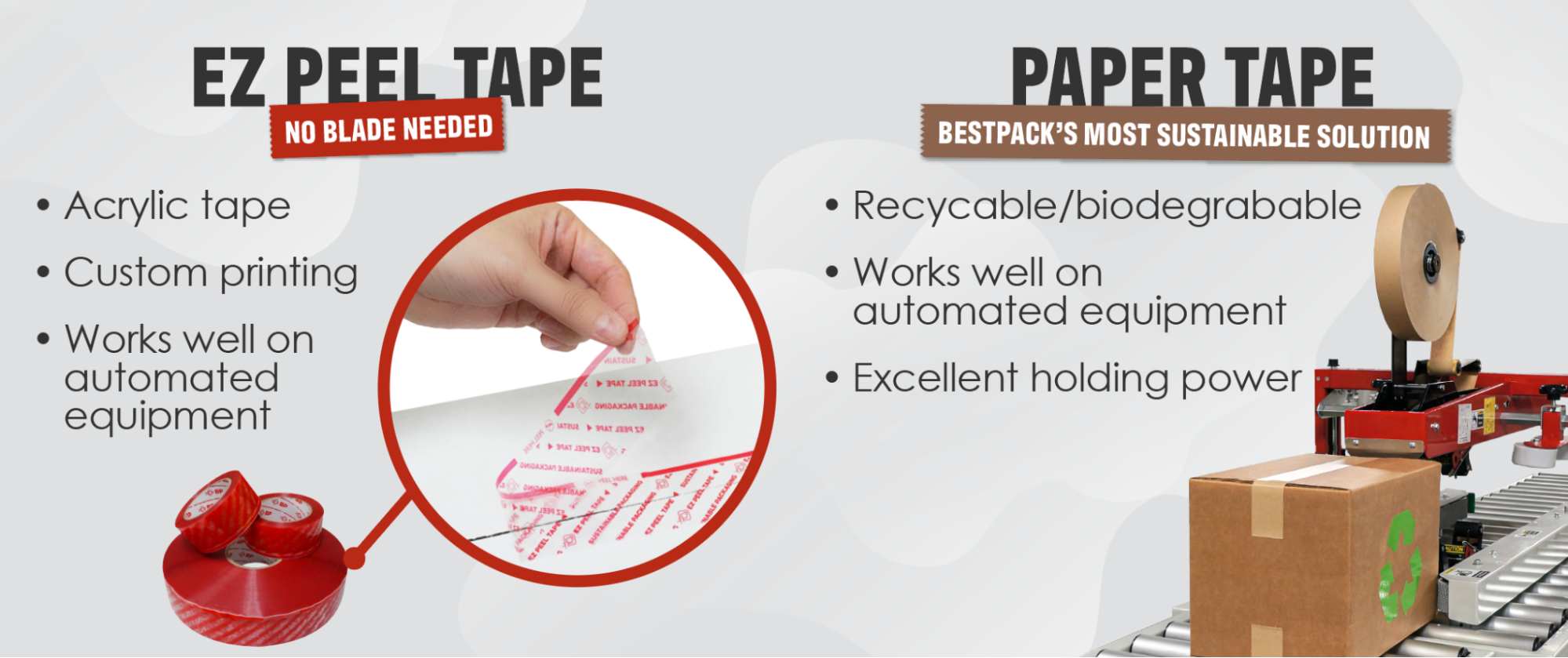
The EZ-Peel Tape features a unique design with deadened adhesive on the edge, making it easy to peel off without having to cut the box. This tape is compatible with standard equipment, ensuring seamless integration into existing packaging processes. Custom print options are available, allowing businesses to incorporate branding elements directly onto the tape.
EZ-Peel Tape is particularly useful for applications where easy access to the contents of the package is essential, such as in retail or consumer goods. Its user-friendly design enhances the customer experience by simplifying the opening process. Additionally, It’s also highly machinable, which means it works exceptionally well in automated solutions. The tape’s durability ensures that it provides a secure seal until it is intentionally removed, protecting the contents during transit and storage.
Paper Tape is our most environmentally friendly option, being both recyclable and biodegradable. This tape offers excellent durability against high and low temperatures, making it suitable for a wide range of environmental conditions. It is an ideal choice for businesses that prioritize sustainability in their packaging practices.
The tape’s strong adhesive properties ensure that it provides a reliable seal, maintaining the integrity of packages during shipping and storage. It works well with automated solutions, making it a great choice for companies looking to reduce their environmental footprint without sacrificing efficiency.
A1: Carton sealing tape comes in several types, each suited for different applications:
A2: To choose the right carton sealing tape, consider the following factors:
A3: Several factors affect tape adhesion and performance:
A4: To properly store boxes after they have been sealed, it is essential to maintain a stable environment. Avoid storing them in areas with extreme temperatures or high humidity, such as attics, basements, or garages, as these conditions can weaken the tape’s adhesive and compromise the box’s integrity. It’s also important to keep the boxes away from direct sunlight, as prolonged UV exposure can degrade the tape over time. For best results, store boxes in a cool, dry place and stack them carefully with heavier boxes on the bottom to prevent crushing and ensure the seals remain intact.
A5: Yes, carton sealing tape has various other uses:
A6: For a strong seal:
A7: Avoid these common mistakes:
As we navigate through 2025, the landscape of carton sealing tape continues to evolve, offering more specialized and efficient solutions than ever before. Understanding the characteristics and applications of various types of sealing tape allows businesses to tailor their packaging strategies to meet specific needs, enhance product security, and streamline operations. From the everyday use of pressure-sensitive tape to the heavy-duty capabilities of other specialized tapes, each type of tape provides distinct advantages that can impact the effectiveness of your packaging.
By leveraging the right carton sealing tape for your particular application, you not only ensure the safe transit and storage of your goods but also contribute to a more efficient and cost-effective packaging process. As technology and materials continue to advance, staying informed about the latest developments in carton sealing tape will help you make strategic choices that benefit your business and your customers.